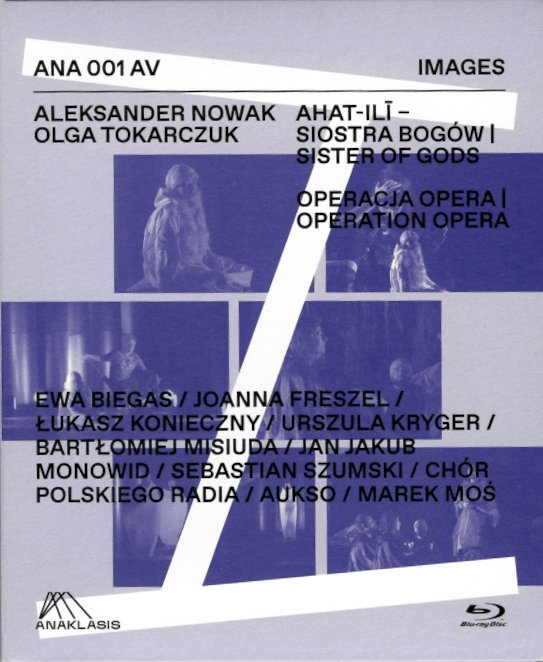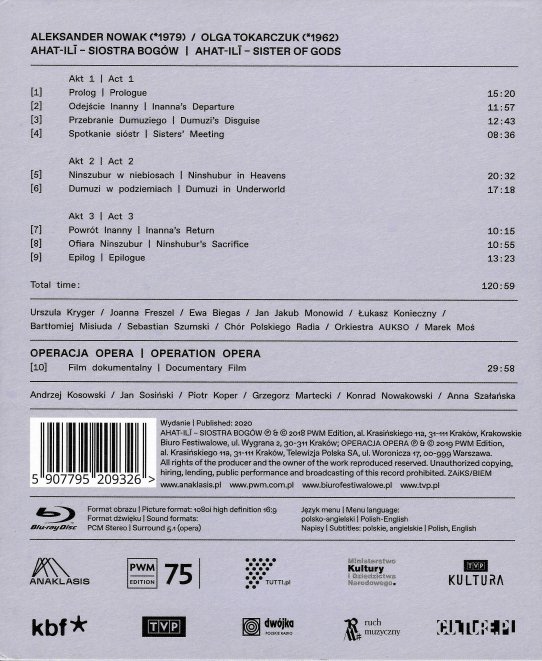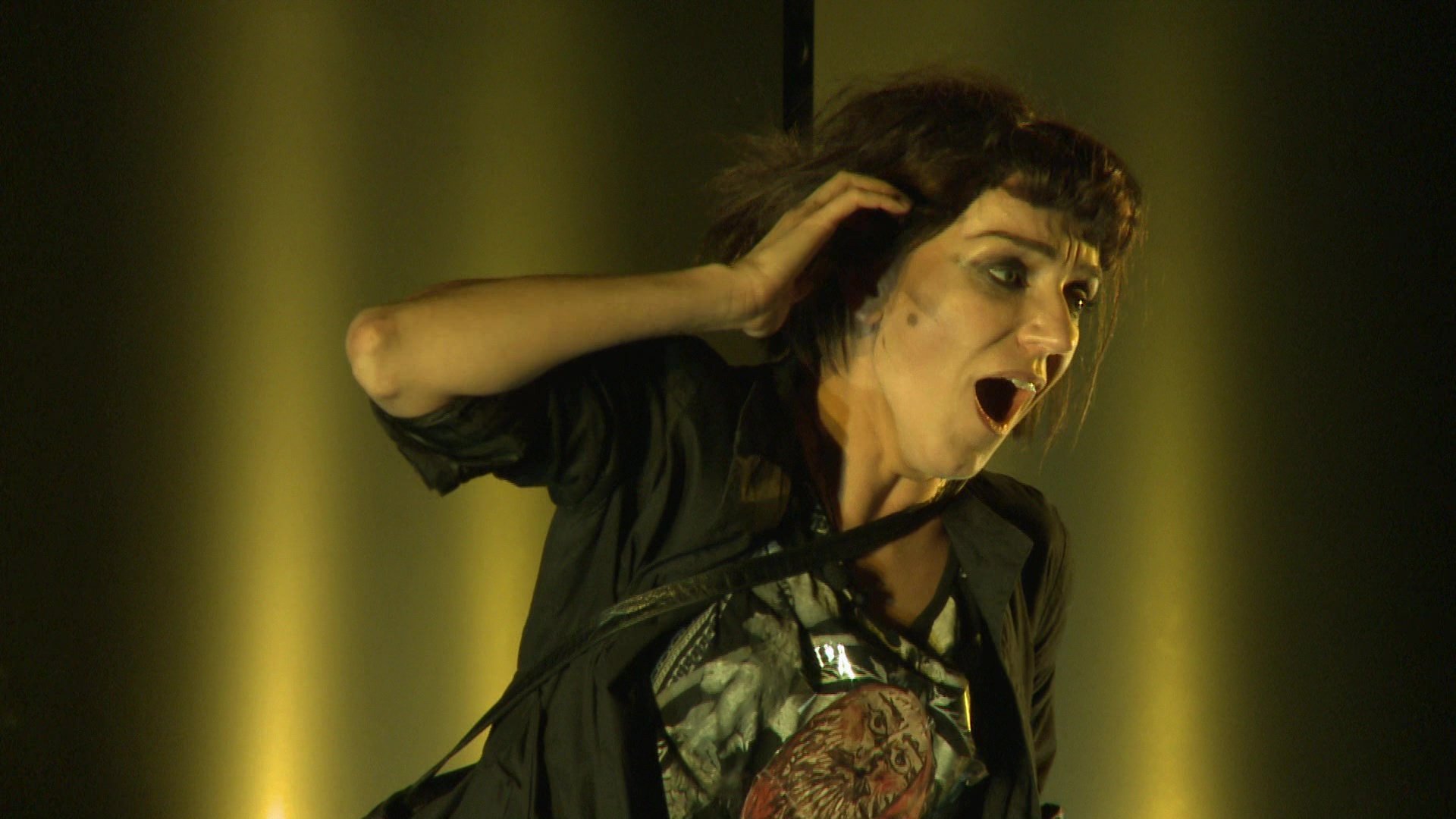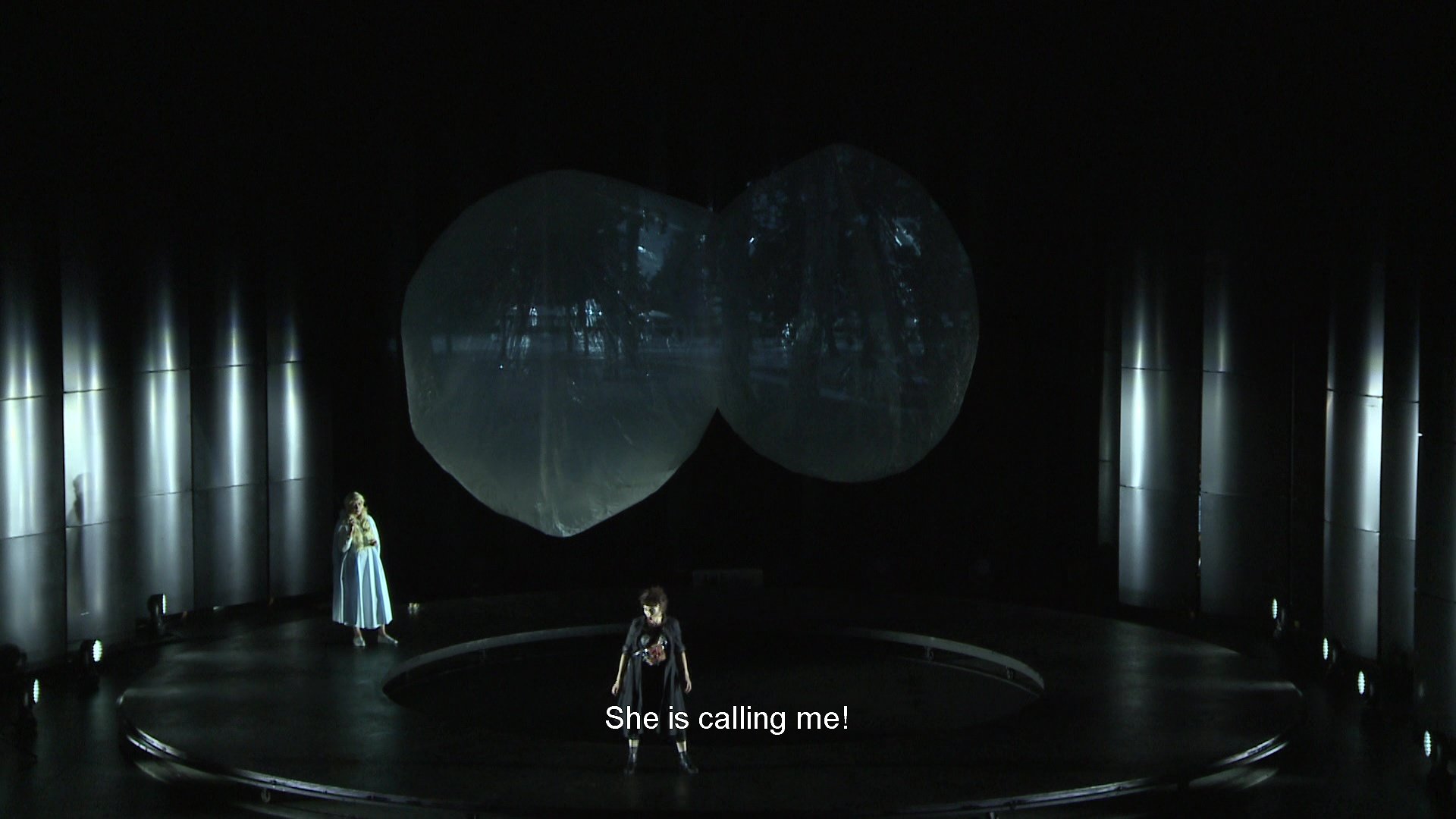

Sister of Gods opera. “Sister of Gods” translates to ahat-ilī [Akkadian] and Siostra bogów (Polish). The actual title of the opera is “Ahat ilī—siostra bogów.“ The libretto was written in Polish, but then translated into English to improve the marketability of the work. So “ahat ilī—Sister of the Gods” is the name you will likely see most often. I call it “Sister of the Gods” to help you find it in our Alphalist. Music by the Pole Aleksander Nowak. Libretto by Pole Olga Tokarczuk inspired by her own novel Anna in the Tombs of the World, which was in turn inspired by ancient Sumerian myth. This performance, the world premiere of the opera, was directed by Pia Partum in 2018 at the Sacrum-Profanum festival in Kraków, Poland. Stars Urszula Kryger (Ninshubur), Joanna Freszel (Inanna), Ewa Biegas (Ereshkigal), Jan Jakub Monowid (Dumuzi), Łukasz Konieczny (Father 1—grammarian and priest), Bartłomiej Misiuda (Father 2—logician), Sebastian Szumski (Father 3—sociobiologist). Marek Moś conducts AUKSO, the Chamber Orchestra of the City of Tychy, and the Polish Radio Choir (Choirmaster Maria Piotrawska-Bogalecka). Stage design and costumes by Magdalena Maciejewska; lighting by Jacqueline Sobiszewski; choreography and assistant direction by Agnieszka Dmochowska-Sławiec; video by Agnieszka Beaupre and Patryk Stokłosa; hanging and circling objects by Franciszek Wardyński. Sung in English with some parts in Akkadian, Latin, Ancient Greek, Proto-Slavic, and Aztec. Directed for TV by Andrzei Kosowski. Exhaustive and beautiful keepcase booklet has complete libretto in English and Polish. Subtitles in English and Polish. Released 2020, disc has 5.1 surround sound. Grade: A+
The world premiere took place at the Krakow International Center for Exhibitions (ICE):
In this daytime view you can see on the horizon buildings in the historic old city. Krakow was spared large-scale destruction in World War II:
The ICE has two modern auditoriums. Sister of the Gods was performed in the smaller hall shown below. The stage was equipped with a turntable. The orchestra was on the floor, which functions as a kind of pit:
Our first streenshot from the opera shows mezzo-soprano Urszula Kryger as Ninshubur. An everywoman, she is the lodestar of the opera. She actually smokes a cigarette on stage. She doesn’t know why the gods call her “sister.” She is a favored servant of Inanna:
Next below is soprano Joanna Freszel as Inanna, the goddess of life. Freszel appears in many pictures as a blond, which would seem to be appropriate for the goddess of life. But for this performance, I think we see her as natural brunette. This world premiere was on a short run at a festival—the director doubtless had a tiny budget with no money for wigs:
Inanna’s husband is Dumuzi, played by countertenor Jan Jakub Monowid. He is the god of nature:
Can you identify the image next below? Try to guess:
The image above is a sea squirt about 15 centimeters long. This squirt was photographed in 2022. HMS Endurance, the ship of British explorer Sir Ernest Shackleton, sank near Antarctica in 1915. Another explorer found the wreck in excellent condition on the ocean bottom under 3007 meters of the coldest water on earth in a realm of eternal total darkness. The most amazing thing is that lots of living creatures had made their home on the wreck, including our squirt. So what does this have to do with Sister of the Gods? Well, in the next image from the opera, director Pia Partum gives us 2 sea squirts to admire. Or are they gasbags, or clouds, or a human egg seconds after a conception yielding twins? Only Pia knows:
Inanna has a twin sister named Ereshkigal, who is the goddess of death. She lives in the underworld, or hell. Ereshkigali commands Inanna to visit hell. Inanna feels she must obey. But if Inanna doesn’t return in 3 days, she instructs Ninshubur to file a missing person report with the fathers in heaven:
There is a lot of trick photographic images in this video file. We get lots of stuff that the audience never saw. Next below are three image merged into one as three voices merge. This video requires strict attention:
Now meet Ewa Biegas as Ereshkigal, the goddess of death. Even without a black wig, this singing actress has no trouble convincing you that you do not want to go to hell. She is the hostess, but her treatment of sister Inanna is not very polite:
There follows a trial in hell before unseen judges. Inanna argues that death should be made illegal. Ereshkigal retorts that death—not life—is the foundation of the universe. The judges condemn Inanna to execution. Inanna is trapped. Soon the entire universe will fall into ruin and cease to exist! Inanna goes missing 3 days. So Ninshubur has to visit the fathers in heaven and file a plea with them for appropriate relief:
Left below is Łukasz Konieczny as Father 1—grammarian and priest. He is an impossible pedant. Below right is Bartłomiej Misiuda as Father 2—a logician. He is a pious propounded of platitudes:
But the gold standard of ineptitude belongs to Sebastian Szumski as Father 3—sociobiologist. As high priest of inertia and convention, he informs Ninshubur that she is in the wrong venue. The fathers have no jurisdiction over the Lady of the Underworld:
These three insufferable bureaucrats offer no aid as they have no power to bring anyone back to life. But they are “working on it.” They do come up with a suggestion: perhaps the Lady in Hell would be more attracted to Dumuzi than to her own (yuck) twin sister. Below is another creation of our own insufferable video editor who gives us three simultaneous views of the fathers in heaven:
Dumuzi, ever game, seduces his wife’s twin sister:
This throws Inanna into an even more horrible dilemma—what good is life without nature?
Ninshubur came to hell with Dumuzi. She has a bright idea. She offers to stay in hell so Inanna and Dumuzi both can go back to the surface and the universe can continue as before:
As everywoman, Nishubur instinctively knows how to seal the deal. She will turn hell into a spa. She will give Ereshkigal the latest hairstyle . . .
Why black nails? Take a look:
Nothing like success. Ninshubur is now a goddess herself. And if she hasn’t died, the universe is still alive:
Pia Partum deserves to do a revival of this for an extended run—this time with a budget for costumes:
As far as I know, Sister of the Gods has been produced only once and performed only a handful of times. The libretto was written by Nobel-prize-winning author Olga Tokarczuk working with the composer of the music, Aleksander Nowak. Now suddenly we have a fine Blu-ray recording of this with a magnificent booklet published by a Polish recording company! What are we to make of this?
Some say that the age of opera ended in 1924 when Puccini died working on Turandot. Since then, I submit that we have received about 10 especially worth-while operas that you can see in Blu-ray: Lulu, Capricio, Peter Grimes, Billy Budd, Rake’s Progress, Vanessa, Dialogue of the Carmelites, Nixon in China, Doctor Atomic, and Brokeback Mountain. I know all these works from Blu-rays except Brokeback Mountain, which is not famous for lyricism. (Einstein on the Beach is not on this list because it may well never be performed again). Of these 10 works, only one, Dialogue of the Carmelites, has enjoyed real popularity world-wide. If opera isn’t dead, it does seem to have entered old age and lost its mind.
But now we have a new opera written, composed, produced, recorded, and published in the relatively small nation of Poland. The libretto is an ancient myth that priests once used to explain the secrets of life, death, and the seasons. But the story is updated to show how free-will can trump fate. And it is laced with all kinds of secondary meanings and humor about Polish history and culture. (If Sister starts to travel, the libretto should be modified to include local color for each country it visits.)
But the really impressive thing is the music. Sister is maybe unique with two sopranos, a mezzo, and counter-tenor as leads. Nowak writes in a completely modern idiom. Like Carmelites, Sister is an opera of ideas with no romance or sex. Nowak injects plenty of drama and dissonance in his score. But there are also many passages suffused with surprising lyric beauty. I submit this beauty equals or surpasses the music in all of the operas listed above other than Poulenc’s Carmelites. Written in 1957, the Carmelites is a mountain alone in the history of opera from 1924 to 2000. Sister may in the future be recognized as a mountain in 21st century opera. Give it a try. Grade: A+
Also check out my synopsis below (missing from the keepcase booklet).
To purchase, please see options available through the Anaklasis website. It seems now that they are set up to ship to Europe but maybe not to the Americas.
Sister of Gods Synopsis
The opera has 9 parts spread across 3 acts.
Act 1
Part 1. Prologue
Ninshubur, a mere human woman, wonders why she is called a “sister” by the gods. Ninshubur is a servant of Inanna.
Part 2. Inanna's Departure
Inanna, the immortal goddess of life, dwells on earth with her husband, Dumuzi, the god of nature. Inanna's twin sister, Ereshkigal, is the goddess of death, who lives in the underworld. Inanna hears her sister calling her to the underworld. Fearing trouble, Dumuzi advises Inanna to ignor Ereshkigal. But Inanna feels she must see Ereshkigal.
Part 3. Dumuzi's Disguise
Exasperated, Dumuzi asks Ninshubur for help so he can go about his important work of making things grow on earth. Ninshubur, always helpful, disguises Dumuzi as a woman dressed in a frock covered with designs of flowers.
Part 4. Sisters' Meeting
Inanna knocks on the gate to the underworld. Ereshkigal warns Inanna that if she enters the underworld, she will die. Inanna bravely enters and there follows a grand trial before unseen Judges. Inanna argues that death should be made illegal. Ereshkigal retorts that death is the foundation of everything. The judges condemn Inanna to death. This is serious—the end of the universe. What to do?
Act 2
Part 5. Ninshubur in Heaven
Inanna has not returned in 3 days. In that event, Inanna instructed Ninshubur to go to the Fathers in heaven for help. The Fathers receive Ninshubur, but they turn out to be insufferable bureaucrats with no jurisdiction over Ereshkigal. They see Dumuzi. Aha! Maybe Ereshkigal would take Dumuzi as her hostage and release Inanna.
Part 6. Dumuzi in the Underworld
Dumuzi seduces Ereshkigal into taking him as hostage and releasing Inanna. The Judges protest. [In the ancient myth, a deal is made with Dumuzi staying 6 months of the year in the Underworld (fall and winter) and returning to earth 6 months (spring and summer).]
Act 3
Part 7. Inanna's Plight.
Inanna has rejected the exchange of hostages, and she is still in the underworld. What good would life be without nature? Ninshubur, rejected by the Fathers, also goes to the underworld to try to rescue Inanna. She asks, “ How much is needed to recompense the death of a god? Six million lives? ” Demons appear with opinions.
Part 8. Ninshubur's Sacrifice.
Inanna unsuccessfully begs Ereshkigal to release Dumuzi. Ninshubur offers to stay in hell herself in exchange for letting both Inanna and Dumuzi go. The deal is clinched when Ninshubur promises to paint Ereshkigal's nails in “black varnish.” Thus Ninsuhbur saves the universe with her sacrifice.
Part 9. Epilogue.
And if they haven't died, Inanna and Dumuzi are still keeping life humming on earth.





























